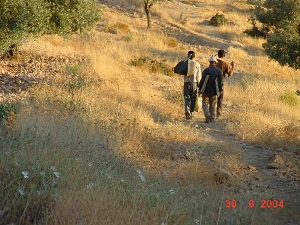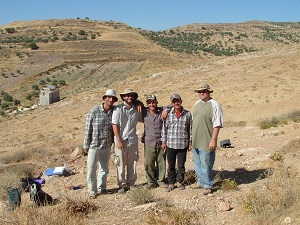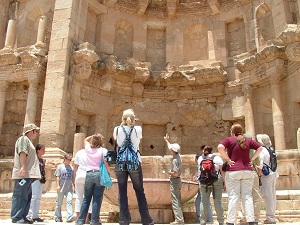Jordan Field School
The King Fahd Middle East Studies Program
University of Arkansas
And
Yarmouk University
Present
Bioarchaeological Field School
Excavation of Late Roman and Byzantine Tombs
Recording & Analysis of Excavated Skeletal Remains
The field school provides:
– Six undergraduate credits –
-Four trips to archaeological sites in Jordan including two days at Petra-
– Round trip airfare to Amman, Jordan (leaving from a major U.S. airport)-
-Housing in Yarmouk University apartments-
-Transportation from Yarmouk University to the site each day
(estimated cost is US $4,100 program fee and $918.06 for 6 hours undergraduate credit and $1,619.94 for 6 hours graduate credit)
Contents:
Course Description
Tuition/Costs
Accommodations
Travel/Field Trips
Past Student Experience
Contact Information
References/Bibliography
Return to Dr.Rose’s Homepage
Visit the Department of Anthropology Homepage
The University Of Arkansas Hompage
Course Description
The summer Bioarchaeological field school is a collaborative effort between the University of Arkansas and Yarmouk University in Irbid, Jordan. The research staff and students come from both America and Jordan and work together throughout the program. No prior field work experience is necessary. Every student works according to his/her experience level. Whenever possible students are given the opportunity to supervise the excavation of a tomb and all have the opportunity for note taking, cataloging, mapping, drawing, and writing final reports. In the past season each of the students was able to supervise the complete excavation of at least one tomb. No knowledge of the Arabic language is necessary. All instruction is in English. All of the Jordanian students participating in the field school are reasonably fluent in English.

In addition to field work, students are assigned to lab work on a rotating schedule. Laboratory sessions held after the field work each day focus on cleaning, cataloging, and preliminary skeletal analysis. Students are encouraged to become involved in areas of specific interest to them.
Besides skeletal remains, many artifacts are excavated as well. Artifacts are excavated in association with skeletal remains. Bronze and iron bracelets, gold earrings, jewelry with semi-precious stones, and Roman glass are examples of artifacts excavated in past seasons.
Tuition & Costs
The estimated cost of the field school is US $4,100. This includes round trip airfare (Memphis, TN or Chicago to Amman, Jordan), local travel, residence in a Yarmouk University apartment, drinking water, and four field trips, including a two-night stay at Petra. Tuition is $918.06 for 6 hours of undergraduate credit and graduate credit is available at a higher rate ($1,619.94). The present estimated total is $4,972.28, but costs and group travel dates (may vary up to two days on either side) will be finalized in January. Out-of-state students and students from other countries pay in-state tuition. All out-of-state students will be classified as in-state students for tuition purposes.
Participants are responsible for: Meals (all apartments are equipped with kitchens); entrance and exit fees; souvenirs; film and developing; and other personal expenses estimated at $1,500-1,700 according to the experience of previous students.
Financial Aid and Scholarships
Financial aid is available for University of Arkansas students from the Financial Aid Office. Visiting students must apply for financial aid through their home institution. Honors College students should apply for Study Abroad grants through Honors studies.
Eligibility
Students must have a cumulative GPA of 2.4 with a minimum of 24 hours. One reference from a faculty member or academic advisor is required.
Accommodations
Students live in Yarmouk University apartments. All apartments are equipped with a telephone, washing machine, and kitchen utensils. Students will be housed two in each bedroom.
Many of the Jordanian students participating in the field school live near the Yarmouk campus. The American students have the opportunity to socialize with the Jordanians in their free time.
The area surrounding the university is a busy student area. There are many small shops, internet cafes, sidewalk restaurants, vegetable stands, and grocery stores. There is a large Safeway store within walking distance of university housing.
Field Trips
Jordan is a nation rich with archaeological sites. Ancient cities, such as Jerash (ancient Gerasa) are still standing, and you will be able to walk ancient Roman roads. Four field trips are included in the field school. Last year students visited Jerash, hiked in Petra, climbed a Crusader castle, and spent an afternoon at a resort on the Dead Sea. Students may take side trips and see sites such as the desert castles, Pella, and Madaba, to name a few.
Past Student Experiences
“The University of Arkansas summer archaeological field school is a great learning experience. Not only do you learn basic archaeological field methods, but you are in an exciting environment and surrounded by a very different culture. Working with Jordanian students enhances the site atmosphere. It was one of the most rewarding opportunities of my life. I would recommend it to anyone.” – Anna Gearhart, now studying biological anthropology at Colorado State University “At first I was nervous since this was my first field school. I realized later that this was a new experience for many of the students. Even the more experienced students were learning new methods and ideas. Excavating tombs in the Middle East is different from North American archaeology. I was learning all of the time. When I was not in the field I learned so much about Jordanian culture. The Jordanian people are warm, gracious, generous people. I made many friends in Jordan that I continue to be in contact with today.” – Rachael Wiest, now a graduate student in anthropology at the University of Arkansas “The field school allows students to get a taste of how archaeology is done in anothercountry. We learned different techniques and methods through hands-on work.” – Melissa Zabecki, currently a PhD student at the University of Arkansas “The field school offers a unique opportunity to gain knowledge in archaeological and osteological techniques, while being immersed in a country with a rich historical and cultural heritage. It will prove to be an experience of a lifetime.” – Trey Batey, currently a PhD student at the University of Arkansas “The summer field school in Jordan was an amazing experience. Learning not only about archaeology, but also a new culture was what made this program so strong. I would highly recommend this to anyone interested in studying abroad.” – Bobby Braly, currently an MA student at the University of Arkansas
Contact Info
Send requests for application materials to:
Fulbright Institute
Attn.: Ms. Dede Long
Office of Study Abroad
722 West Maple
Fayetteville, AR 72701
Telephone: 479-575-7582 Fax: 479-575-7402
Email the Study Abroad Office at:
studyabr@uark.edu
Email Dr. Jerome Rose at:
jcrose@uark.edu
ATTENTION: The application deadline will be 16 February, 2007.
Applicants must have a valid passport no later than March 1 in order for the diggeing permits to be issued by the starting date of the field school
Bibliography
Burke, Dolores L., and Jerome C. Rose. “2001 Jordanie Ya camun: Les Morts de Ya camun.” Le Monde de la Bible 133 (March 2001): 56. [also *]
Burke, Dolores L., and Nizar Turshan. “Ya’amun.” ACOR Newsletter 16.2 (Winter 2004).
Hunton, Charles N. II and Dolores L. Burke. “Tell Ya camun.” In “Archaeology in Jordan,” American Journal of Archaeology, 106.3 (July 2000), p. 442.
McGinnis, Shelley, and Mahmoud El-Najjar. “Sa cad.” In “Archaeology in Jordan,” edited by Virginia Egan and Patricia M. Bikai. American Journal of Archaeology 102 (1998): 604-605.
Mittmann, Siegfried, and Dieter Vieweger. Abhandlungen des Deutschen Palästina-Vereins. Weisbaden: Verlag, 1997.
El-Najjar, Mahmoud, Fatima Al-Awad, Jerome Rose, and Saleh Sari. “Dental Pathology as an Indicator of Health at Sa cad: A Late Byzantine Site in Northern Jordan.” Mu’tah Lil-Buhuth wad-Dirasat 19 (2004).
El-Najjar, Mahmoud, Jerome C. Rose, and Nizar Turshan. “Excavation Works at the Archaeological Site of Yasileh.” Newsletter of the Institute of Anthropology and Archaeology No. 22 (2000).
El-Najjar, Mahmoud, Jerome C. Rose, Attalla Nabil, Nizar Turshan, and Dolores L. Burke. “First Season of Excavation at Ya camun (1999).” Annual of the Department of Antiquities of Jordan 45 (2001): 413-417.
El-Najjar, Mahmoud, Jerome C. Rose, Nizar Turshan, Dolores L. Burke, and Attalla Nabil. “Second Season of Excavation at Ya camun (2000).” Newsletter of the Institute of Anthropology and Archaeology No. 23 (2001).
El-Najjar, Mahmoud, Jerome C. Rose, and Nizar Turshan. “Yasileh.” Newsletter of the Institute of Anthropology and Archaeology No. 21 (1999).
El-Najjar, Mahmoud, Jerome C. Rose, and Nizar Turshan. “Ya camun.” Newsletter of the Institute of Anthropology and Archaeology No. 22 (2000).
El-Najjar, Mahmoud, Jerome C. Rose, Nizar Turshan, and Dolores L. Burke. “Preliminary Report on the 2003 Field Season at Ya camun.” Newsletter of the Faculty of Archaeology and Anthropology No. 26 (2004).
Renfro, Bryan. “Bioarchaeological Investigations at Yasileh.” In “Archaeology in Jordan,” edited by Virginia Egan and Patricia M. Bikai. American Journal of Archeology 103 (1999).
Renfro, Bryan, and H. Kory Cooper. “Ya camun.” In “Archaeology in Jordan,” edited by Virginia Egan, Patricia M. Bikai, and Kurt Zamura. American Journal of Archeology 104 (2000).
Rose, Jerome C., and Dolores L. Burke, editors. Sa’ad: A Late Roman/Byzantine Site in North Jordan. Irbid, Jordan: Yarmouk University Publications, Office of the Dean of Research and Graduate Studies, 2004.
Rose, Jerome C., Dolores L. Burke, and Mahmoud El-Najjar. “News from Jordan.” Paleopathology Newsletter No. 108 (December 1999): 4.
Rose, Jerome C., Mahmoud El-Najjar, Nizar Turshan, and Saleh Sari. “Sa cad Preliminary Report.” Newsletter of the Institute of Anthropology and Archaeology No. 20 (1997).
Rose, Jerome C., Mahmoud El-Najjar, Nizar Turshan, Charles N. Hunton II, and Kimberly Rolf. “Tell Ya camun.” In “Archaeology in Jordan,” American Journal of Archaeology 107.3 (July 2003), p. 457.
Al-Shiyab, Abdel Halim, Jerome C. Rose, Nizar Turshan, and Charles N. Hunton II. “Field Excavations at the Archaeological Site of Ya camun (2001) .” Newsletter of the Institute of Anthropology and Archaeology No. 24 (2002).
Al-Shorman, Abdulla Alakkam. “Archaeological Site Distribution in Jordan Since the Paleolithic and the Role of Climate Change.” Adumatu No. 5: 2002.
Al-Shorman, Abdulla Alakkam. “Archaeological Site Distribution in Jordan since the Paleolithic and the Role of Climate Change.” Adumatu No. 5 (January 2002): 7-26.
Al-Shorman, Abdulla. “Forensic Examination of a Desiccated Body from Southern Jordan Valley.” Anthropologie XLIII/I (2005): 51-55.
Al-Shorman, Abdulla. “The Middle and Late Bronze Age Climate of Ya camoun in Northern Jordan Using Oxygen Isotope Analysis from Human Tooth Enamel.” Adumatu No. 6 (July 2002): 23-26.
Al-Shorman, Abdulla. “Soil Phosphorous, Magnesium and Calcium Analyses at Tell Ya camoun in Northern Jordan.” Mu’tah Lil-Buhuth wad-Dirasat 19 No. 3 (2004).
Al-Shorman, Abdulla. “Three Cemeteries and a Byzantine Church: a ritual landscape at Yasieleh, Jordan.” Antiquity 78 (2004): 113-120.







